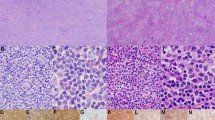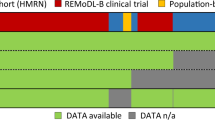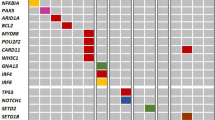Abstract
Follicular lymphoma is an incurable B cell malignancy1 characterized by the t(14;18) translocation and mutations affecting the epigenome2,3. Although frequent gene mutations in key signaling pathways, including JAK-STAT, NOTCH and NF-κB, have also been defined2,3,4,5,6,7, the spectrum of these mutations typically overlaps with that in the closely related diffuse large B cell lymphoma (DLBCL)6,7,8,9,10,11,12,13. Using a combination of discovery exome and extended targeted sequencing, we identified recurrent somatic mutations in RRAGC uniquely enriched in patients with follicular lymphoma (17%). More than half of the mutations preferentially co-occurred with mutations in ATP6V1B2 and ATP6AP1, which encode components of the vacuolar H+-ATP ATPase (V-ATPase) known to be necessary for amino acid−induced activation of mTORC1. The RagC variants increased raptor binding while rendering mTORC1 signaling resistant to amino acid deprivation. The activating nature of the RRAGC mutations, their existence in the dominant clone and their stability during disease progression support their potential as an excellent candidate for therapeutic targeting.
This is a preview of subscription content, access via your institution
Access options
Subscribe to this journal
Receive 12 print issues and online access
$209.00 per year
only $17.42 per issue
Buy this article
- Purchase on Springer Link
- Instant access to full article PDF
Prices may be subject to local taxes which are calculated during checkout




Similar content being viewed by others
Change history
12 January 2016
In the version of this article initially published online, several funding sources were omitted from the Acknowledgments section. The error has been corrected for the print, PDF and HTML versions of this article.
References
Swenson, W.T. et al. Improved survival of follicular lymphoma patients in the United States. J. Clin. Oncol. 23, 5019–5026 (2005).
Okosun, J. et al. Integrated genomic analysis identifies recurrent mutations and evolution patterns driving the initiation and progression of follicular lymphoma. Nat. Genet. 46, 176–181 (2014).
Pasqualucci, L. et al. Genetics of follicular lymphoma transformation. Cell Reports 6, 130–140 (2014).
Karube, K. et al. Recurrent mutations of NOTCH genes in follicular lymphoma identify a distinctive subset of tumours. J. Pathol. 234, 423–430 (2014).
Yildiz, M. et al. Activating STAT6 mutations in follicular lymphoma. Blood 125, 668–679 (2015).
Morin, R.D. et al. Somatic mutations altering EZH2 (Tyr641) in follicular and diffuse large B-cell lymphomas of germinal-center origin. Nat. Genet. 42, 181–185 (2010).
Pasqualucci, L. et al. Inactivating mutations of acetyltransferase genes in B-cell lymphoma. Nature 471, 189–195 (2011).
Compagno, M. et al. Mutations of multiple genes cause deregulation of NF-κB in diffuse large B-cell lymphoma. Nature 459, 717–721 (2009).
Lenz, G. et al. Oncogenic CARD11 mutations in human diffuse large B cell lymphoma. Science 319, 1676–1679 (2008).
Lohr, J.G. et al. Discovery and prioritization of somatic mutations in diffuse large B-cell lymphoma (DLBCL) by whole-exome sequencing. Proc. Natl. Acad. Sci. USA 109, 3879–3884 (2012).
Ngo, V.N. et al. Oncogenically active MYD88 mutations in human lymphoma. Nature 470, 115–119 (2011).
Morin, R.D. et al. Frequent mutation of histone-modifying genes in non-Hodgkin lymphoma. Nature 476, 298–303 (2011).
Pasqualucci, L. et al. Analysis of the coding genome of diffuse large B-cell lymphoma. Nat. Genet. 43, 830–837 (2011).
Bödör, C. et al. EZH2 mutations are frequent and represent an early event in follicular lymphoma. Blood 122, 3165–3168 (2013).
Green, M.R. et al. Hierarchy in somatic mutations arising during genomic evolution and progression of follicular lymphoma. Blood 121, 1604–1611 (2013).
Beà, S. et al. Landscape of somatic mutations and clonal evolution in mantle cell lymphoma. Proc. Natl. Acad. Sci. USA 110, 18250–18255 (2013).
Landau, D.A. et al. Evolution and impact of subclonal mutations in chronic lymphocytic leukemia. Cell 152, 714–726 (2013).
Lohr, J.G. et al. Widespread genetic heterogeneity in multiple myeloma: implications for targeted therapy. Cancer Cell 25, 91–101 (2014).
Morin, R.D. et al. Mutational and structural analysis of diffuse large B-cell lymphoma using whole-genome sequencing. Blood 122, 1256–1265 (2013).
Schmitz, R. et al. Burkitt lymphoma pathogenesis and therapeutic targets from structural and functional genomics. Nature 490, 116–120 (2012).
Gao, J. et al. Integrative analysis of complex cancer genomics and clinical profiles using the cBioPortal. Sci. Signal. 6, pl1 (2013).
Nakashima, N., Noguchi, E. & Nishimoto, T. Saccharomyces cerevisiae putative G protein, Gtr1p, which forms complexes with itself and a novel protein designated as Gtr2p, negatively regulates the Ran/Gsp1p G protein cycle through Gtr2p. Genetics 152, 853–867 (1999).
Sekiguchi, T., Hirose, E., Nakashima, N., Ii, M. & Nishimoto, T. Novel G proteins, Rag C and Rag D, interact with GTP-binding proteins, Rag A and Rag B. J. Biol. Chem. 276, 7246–7257 (2001).
Kim, E., Goraksha-Hicks, P., Li, L., Neufeld, T.P. & Guan, K.L. Regulation of TORC1 by Rag GTPases in nutrient response. Nat. Cell Biol. 10, 935–945 (2008).
Sancak, Y. et al. The Rag GTPases bind raptor and mediate amino acid signaling to mTORC1. Science 320, 1496–1501 (2008).
Bar-Peled, L. et al. A tumor suppressor complex with GAP activity for the Rag GTPases that signal amino acid sufficiency to mTORC1. Science 340, 1100–1106 (2013).
Bar-Peled, L., Schweitzer, L.D., Zoncu, R. & Sabatini, D.M. Ragulator is a GEF for the Rag GTPases that signal amino acid levels to mTORC1. Cell 150, 1196–1208 (2012).
Sancak, Y. et al. Ragulator-Rag complex targets mTORC1 to the lysosomal surface and is necessary for its activation by amino acids. Cell 141, 290–303 (2010).
Zoncu, R. et al. mTORC1 senses lysosomal amino acids through an inside-out mechanism that requires the vacuolar H+-ATPase. Science 334, 678–683 (2011).
Rebsamen, M. et al. SLC38A9 is a component of the lysosomal amino acid sensing machinery that controls mTORC1. Nature 519, 477–481 (2015).
Wang, S. et al. Metabolism. Lysosomal amino acid transporter SLC38A9 signals arginine sufficiency to mTORC1. Science 347, 188–194 (2015).
Forgac, M. Vacuolar ATPases: rotary proton pumps in physiology and pathophysiology. Nat. Rev. Mol. Cell Biol. 8, 917–929 (2007).
Jansen, E.J. & Martens, G.J. Novel insights into V-ATPase functioning: distinct roles for its accessory subunits ATP6AP1/Ac45 and ATP6AP2/(pro) renin receptor. Curr. Protein Pept. Sci. 13, 124–133 (2012).
Iadevaia, V., Huo, Y., Zhang, Z., Foster, L.J. & Proud, C.G. Roles of the mammalian target of rapamycin, mTOR, in controlling ribosome biogenesis and protein synthesis. Biochem. Soc. Trans. 40, 168–172 (2012).
Ben-Sahra, I., Howell, J.J., Asara, J.M. & Manning, B.D. Stimulation of de novo pyrimidine synthesis by growth signaling through mTOR and S6K1. Science 339, 1323–1328 (2013).
Tsun, Z.Y. et al. The folliculin tumor suppressor is a GAP for the RagC/D GTPases that signal amino acid levels to mTORC1. Mol. Cell 52, 495–505 (2013).
Feig, L.A. & Cooper, G.M. Relationship among guanine nucleotide exchange, GTP hydrolysis, and transforming potential of mutated ras proteins. Mol. Cell. Biol. 8, 2472–2478 (1988).
Feig, L.A. Tools of the trade: use of dominant-inhibitory mutants of Ras-family GTPases. Nat. Cell Biol. 1, E25–E27 (1999).
John, J. et al. Kinetic and structural analysis of the Mg2+-binding site of the guanine nucleotide–binding protein p21H-ras. J. Biol. Chem. 268, 923–929 (1993).
Hara, K. et al. Amino acid sufficiency and mTOR regulate p70 S6 kinase and eIF-4E BP1 through a common effector mechanism. J. Biol. Chem. 273, 14484–14494 (1998).
Nicklin, P. et al. Bidirectional transport of amino acids regulates mTOR and autophagy. Cell 136, 521–534 (2009).
Hoffenberg, S. et al. Functional and structural interactions of the Rab5 D136N mutant with xanthine nucleotides. Biochem. Biophys. Res. Commun. 215, 241–249 (1995).
Schmidt, G. et al. Biochemical and biological consequences of changing the specificity of p21ras from guanosine to xanthosine nucleotides. Oncogene 12, 87–96 (1996).
Farnsworth, C.L. & Feig, L.A. Dominant inhibitory mutations in the Mg2+-binding site of RasH prevent its activation by GTP. Mol. Cell. Biol. 11, 4822–4829 (1991).
Lai, C.C., Boguski, M., Broek, D. & Powers, S. Influence of guanine nucleotides on complex formation between Ras and CDC25 proteins. Mol. Cell. Biol. 13, 1345–1352 (1993).
Proud, C.S. Guanine nucleotides, protein phosphorylation and the control of translation. Trends Biochem. Sci. 11, 73–77 (1986).
Krengel, U. et al. Three-dimensional structures of H-ras p21 mutants: molecular basis for their inability to function as signal switch molecules. Cell 62, 539–548 (1990).
Li, H. & Durbin, R. Fast and accurate short read alignment with Burrows-Wheeler transform. Bioinformatics 25, 1754–1760 (2009).
DePristo, M.A. et al. A framework for variation discovery and genotyping using next-generation DNA sequencing data. Nat. Genet. 43, 491–498 (2011).
Koboldt, D.C. et al. VarScan 2: somatic mutation and copy number alteration discovery in cancer by exome sequencing. Genome Res. 22, 568–576 (2012).
Dayem Ullah, A.Z., Lemoine, N.R. & Chelala, C. SNPnexus: a web server for functional annotation of novel and publicly known genetic variants (2012 update). Nucleic Acids Res. 40, W65–W70 (2012).
Saitou, N. & Nei, M. The neighbor-joining method: a new method for reconstructing phylogenetic trees. Mol. Biol. Evol. 4, 406–425 (1987).
Van Loo, P. et al. Allele-specific copy number analysis of tumors. Proc. Natl. Acad. Sci. USA 107, 16910–16915 (2010).
Langmead, B. & Salzberg, S.L. Fast gapped-read alignment with Bowtie 2. Nat. Methods 9, 357–359 (2012).
Li, H. et al. The Sequence Alignment/Map format and SAMtools. Bioinformatics 25, 2078–2079 (2009).
Law, C.W., Chen, Y., Shi, W. & Smyth, G.K. voom: precision weights unlock linear model analysis tools for RNA-seq read counts. Genome Biol. 15, R29 (2014).
Ritchie, M.E. et al. limma powers differential expression analyses for RNA-sequencing and microarray studies. Nucleic Acids Res. 43, e47 (2015).
Subramanian, A. et al. Gene set enrichment analysis: a knowledge-based approach for interpreting genome-wide expression profiles. Proc. Natl. Acad. Sci. USA 102, 15545–15550 (2005).
Boussif, O. et al. A versatile vector for gene and oligonucleotide transfer into cells in culture and in vivo: polyethylenimine. Proc. Natl. Acad. Sci. USA 92, 7297–7301 (1995).
Acknowledgements
We are indebted to the patients for donating tumor specimens as part of this study. We thank G. Clark at the Francis Crick Institute for automated DNA sequencing and the Queen Mary University of London Genome Centre for Illumina MiSeq sequencing. We acknowledge the support of Barts, Cambridge, Leeds and Southampton's Experimental Cancer Medicine and Cancer Research UK Centers. This work was supported by grants from the Kay Kendall Leukaemia Fund and Cancer Research UK (awarded to J.F.), grants from the US National Institutes of Health (NIH; R01 CA103866 and AI47389) and the US Department of Defense (W81XWH-07-0448) to D.M.S., and fellowship support from the US NIH to R.L.W. (T32 GM007753 and F30 CA189333). D.M.S. is an investigator of the Howard Hughes Medical Institute. J.O. is a recipient of the Kay Kendall Leukaemia Fund Junior Clinical Research Fellowship (KKL 557).
Author information
Authors and Affiliations
Contributions
J.O. and J.F. conceived the study. J.O., D.M.S. and J.F. directed the study. C.M., G.P., P.J., A.D., J.C.S., M.-Q.D., S.B., A.J., T.A.L., R.A., S.M. and J.G.G. provided patient samples and clinical data. M.C., A.J. and M.-Q.D. conducted pathological review of specimens. J.M. collated clinical information. S.I. prepared and processed samples. H.Q. provided cell line DNA. J.O., R.L.W., S.A., L.W., B.M.C., L.E.-I., A.F.A.S., A.C., A.E., C.B. and R.Z. performed experiments. J.W., J.A.G.-A., S.H.B. and C.C. performed the bioinformatic analysis. J.R. and R.S. coordinated and verified the ICGC data set. J.O., R.L.W., J.W., D.M.S. and J.F. analyzed and interpreted the data. J.O., R.L.W., D.M.S. and J.F. wrote the manuscript. All authors read and approved the final manuscript.
Corresponding authors
Ethics declarations
Competing interests
The authors declare no competing financial interests.
Integrated supplementary information
Supplementary Figure 1 Clinical timeline for the discovery WES cases.
This illustrates the timeline of the disease events during the clinical course of each patient’s disease, further indicating the available samples that were sequenced in this study.
Supplementary Figure 2 Phylogenetic reconstruction demonstrating the clonal evolution history of each of the five WES cases.
In each case, a phylogenetic tree was constructed using the somatic nonsynonymous variants detected in the WES analyses. All trees are rooted at the germline (GL) sequence, with the trunk of the tree representing variants shared by all the tumor biopsies, depicting a common ancestral origin. Internal branches indicate variants that are shared by more than one subsequent progressed or relapse tumor, and the terminal branches illustrate variants that are unique or phase specific to that biopsy alone. Early initiating genes are shown on the trunk of the tree. Novel genes identified in this study (RRAGC, ATP6V1B2 and ATP6AP1) are also illustrated. For RRAGC mutations, the superscript numbers in cases B2, B3 and B4 indicate the different RRAGC mutations identified in those individual biopsies.
Supplementary Figure 3 Copy number of RRAGC as compared to other gene loci.
The top panel shows the log R values for each of the gene loci indicated from all 24 samples from the five WES cases, and the bottom panel shows the log R values from our previously published SNP6.0 data set comprising 29 different follicular lymphoma samples and corresponding paired transformed follicular lymphoma. The gene locus for TNFRSF14, 1p36.32, was chosen as a reference locus as it is commonly subject to frequent copy number deletions in follicular lymphoma. The horizontal dashed line indicates the log R value of −0.2, with values below this measure indicative of deletions and those above 0.2 indicative of gains, as reported previously3.
Supplementary Figure 4 Model of components of the amino acid–induced mTORC1 pathway.
At low amino acid levels (left), the Rag heterodimer (RagB-RagC) is in a nucleotide-bound configuration incompatible for the recruitment and activation of mTORC1. In the presence of sufficient amino acids (right), a supercomplex comprising the v-ATPase, Ragulator, SLC38A9 and the Rag GTPase heterodimer translocates to the lysosomal surface. This changes the Rag heterodimer into its active form with RagB being GTP bound and RagC being GDP bound, resulting in the recruitment and activation of mTORC1.
Supplementary Figure 5 Differential gene expression between RRAGC-mutated and wild-type follicular lymphoma cases.
(a) Heat map from the unsupervised hierarchical clustering of genes that are differentially expressed in RRAGC-mutated (red bar; n = 5) and wild-type (blue bar; n = 8) tumors. This consisted of 75 upregulated and 182 downregulated genes, selected on the basis of a double threshold of raw P value < 0.01 and absolute fold change >2. (b) Mean gene expression values for RRAGC, MTOR and the other Rag GTPases. No difference in expression was noted between RRAGC-mutated and wild-type tumors. Expression values were measured using voom log2-cpm (read count per million reads).
Supplementary Figure 6 Representative GSEA plots.
GSEA of gene expression data derived from RNA-seq of five RRAGC-mutated versus eight RRAGC–wild type cases. This showed significant enrichment for gene sets in several processes involved in translation and cell cycle regulation, which were upregulated in the RRAGC-mutated tumors as compared to wild-type tumors. Hits displayed below the graph show where the members of the gene set appear in the ranked list of genes. FDR q values and further gene sets are fully listed in Supplementary Table 10.
Supplementary Figure 7 Recurrent follicular lymphoma RagC mutants activate the mTORC1 pathway.
(a) Follicular lymphoma RagC mutants (RagCS75F, RagCS75N, RagCT90N and RagCW115R) dramatically increase mTORC1 binding (mTOR and raptor), whereas RRAGC mutations identified in solid cancers (p.M121V, p.Y165C, p.D202G, p.L217R and p.R396Q) did not coimmunoprecipitate mTORC1 as strongly. Anti-FLAG immunoprecipitates were collected and analyzed as in Figure 3a. (b) All four RagC mutants coimmunoprecipitate more raptor than wild-type RagC in Raji cells. Anti-FLAG immunoprecipitates from Raji cells stably expressing the indicated proteins were collected and analyzed as in Figure 3a. (c) Three RagC mutants (RagCS75N, RagCS75F and RagCW115R) coimmunoprecipitate more raptor than wild-type RagC when overexpressed in OCI-Ly7 cells. Anti-FLAG immunoprecipitates from OCI-Ly7 cells stably expressing the indicated proteins were collected and analyzed as in Figure 3a. (d) Four RagC mutants increase raptor binding over wild-type RagC in OCI-Ly8 cells. Anti-FLAG immunoprecipitates from Ly8 cells stably expressing the indicated proteins were collected and analyzed as in Figure 3a. (e) Stable overexpression of RagCS75N, RagCS75F, RagCT90N and RagCW115R renders the cells partially insensitive to full amino acid deprivation. HEK293T cells that stably expressed the indicated proteins were starved of amino acids for 50 min and restimulated with amino acids for 10 min. The cell lysates were analyzed as in Figure 3b. (f) Quantification of the amount of phosphorylated S6K1 in Figure 3c, under leucine starvation or starvation followed by restimulation in HEK293T cells stably expressing the indicated proteins. (g) Quantification of the amount of phosphorylated S6K1 in Figure 3d, under arginine starvation or starvation followed by restimulation in HEK293T cells stably expressing the indicated proteins. (h) Quantification of the amount of phosphorylated S6K1 in Figure 3e, under leucine starvation or starvation followed by restimulation in Karpas-422 cells stably expressing the indicated proteins.
Supplementary information
Supplementary Text and Figures
Supplementary Figures 1–7 and Supplementary Tables 1 and 2 (PDF 1711 kb)
41588_2016_BFng3473_MOESM32_ESM.xls
Supplementary Tables 4: List of somatic variants identified from whole exome sequencing 5 cases (24 tumor biopsies) (XLS 337 kb)
41588_2016_BFng3473_MOESM38_ESM.xls
Supplementary Table 10: Top significantly enriched gene sets for RRAGC mutants compared to wild-type comparison using the GSEA tool MSigDB collections (XLS 76 kb)
Rights and permissions
About this article
Cite this article
Okosun, J., Wolfson, R., Wang, J. et al. Recurrent mTORC1-activating RRAGC mutations in follicular lymphoma. Nat Genet 48, 183–188 (2016). https://doi.org/10.1038/ng.3473
Received:
Accepted:
Published:
Issue Date:
DOI: https://doi.org/10.1038/ng.3473
This article is cited by
-
Raptor mediates the selective inhibitory effect of cardamonin on RRAGC-mutant B cell lymphoma
BMC Complementary Medicine and Therapies (2023)
-
The molecular basis of nutrient sensing and signalling by mTORC1 in metabolism regulation and disease
Nature Reviews Molecular Cell Biology (2023)
-
Genomic landscape of mature B-cell non-Hodgkin lymphomas — an appraisal from lymphomagenesis to drug resistance
Journal of the Egyptian National Cancer Institute (2022)
-
A Rag GTPase dimer code defines the regulation of mTORC1 by amino acids
Nature Cell Biology (2022)
-
Brain-enriched RagB isoforms regulate the dynamics of mTORC1 activity through GATOR1 inhibition
Nature Cell Biology (2022)



